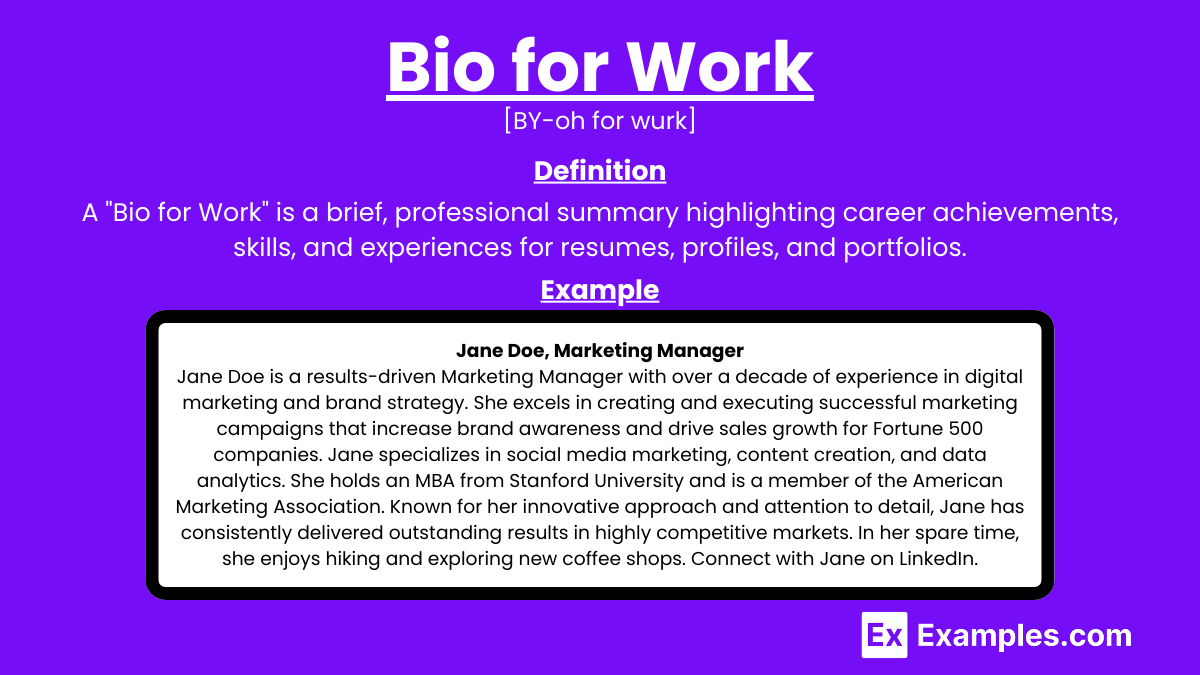20+ Bio for Work Examples
In the professional world, first impressions are crucial, and often, your bio is the first thing potential employers, clients, or colleagues will see about you. A well-crafted bio can set the tone for your professional image, highlight your skills and experiences, and make you stand out from the crowd. This article will guide you through the process of creating a compelling bio for work.
What is a Bio for Work?
A bio for work is a brief, professional summary highlighting your career achievements, skills, and experiences. It’s used on resumes, LinkedIn profiles, company websites, and professional portfolios. A strong bio should be concise, engaging, and tailored to your industry, showcasing your unique value and expertise to potential employers or clients.
Bio for Work Samples
1. Marketing Manager Bio:
Jane Doe is a results-driven Marketing Manager with over a decade of experience in digital marketing and brand strategy. She has successfully led campaigns that increased brand awareness and drove sales growth for Fortune 500 companies. Jane specializes in social media marketing, content creation, and data analytics. She holds an MBA from Stanford University.
2. Software Developer Bio:
John Smith is a Senior Software Developer with expertise in building scalable web applications. With 8+ years in the tech industry, John has contributed to developing innovative software solutions for startups and established enterprises. He is proficient in Java, Python, and JavaScript, and holds a B.S. in Computer Science from MIT.
3. Graphic Designer Bio:
Emily Johnson is a creative Graphic Designer with a knack for visual storytelling. With 6 years of experience, she has worked with various clients to design compelling logos, brochures, and websites. Emily’s work is known for its clean, modern aesthetic and attention to detail. She graduated with a BFA in Graphic Design from the Rhode Island School of Design.
4. Project Manager Bio:
Michael Brown is a certified Project Management Professional (PMP) with over 15 years of experience in leading cross-functional teams to deliver complex projects on time and within budget. He has a proven track record in the IT and construction industries. Michael excels in project planning, risk management, and stakeholder communication. He holds a Master’s degree in Project Management from George Washington University.
5. HR Specialist Bio:
Lisa Green is an accomplished HR Specialist with a strong background in employee relations, recruitment, and performance management. With 10 years in the field, she has implemented effective HR strategies that enhanced workplace culture and boosted employee retention. Lisa is SHRM-CP certified and has a Bachelor’s degree in Human Resources from the University of Texas at Austin.
Examples of Bio for Work
1. Content Strategist Bio:
Sarah Davis is a seasoned Content Strategist with a passion for crafting compelling narratives. With over 12 years in the industry, she has developed content strategies for leading brands, boosting engagement and driving customer loyalty. Sarah excels in SEO, copywriting, and content management systems. She holds a Master’s degree in Communications from Northwestern University.
2. Data Scientist Bio:
Amit Patel is a Data Scientist with a strong background in statistical analysis and machine learning. Over the past 7 years, Amit has worked on high-impact projects that transformed data into actionable insights for top financial firms. He is proficient in R, Python, and SQL, and holds a Ph.D. in Data Science from the University of California, Berkeley.
3. Public Relations Specialist Bio:
Maria Gonzales is an experienced Public Relations Specialist known for her strategic communication skills. With 9 years of experience, she has successfully managed PR campaigns that enhanced brand reputation and visibility. Maria specializes in media relations, crisis communication, and event planning. She earned her Bachelor’s degree in Public Relations from New York University.
4. UX/UI Designer Bio:
David Lee is a creative UX/UI Designer dedicated to improving user experiences through intuitive design. With 5 years of experience in the tech industry, David has designed user-friendly interfaces for both mobile and web applications. His expertise includes wireframing, prototyping, and user testing. David holds a Bachelor’s degree in Interaction Design from the School of Visual Arts.
5. Financial Analyst Bio:
Rachel Kim is a skilled Financial Analyst with a keen eye for detail and strong analytical abilities. With 8 years of experience in the finance sector, Rachel has provided valuable insights that helped businesses optimize their financial performance. She specializes in financial modeling, budgeting, and forecasting. Rachel holds an MBA in Finance from the Wharton School of the University of Pennsylvania.
Bio for Work Examples for Students
1. Marketing Intern Bio:
John Doe is a Marketing Intern currently pursuing a Bachelor’s degree in Business Administration at the University of California, Berkeley. He has experience in social media management and content creation through his work with the campus marketing club. John is passionate about digital marketing and analytics, and he is eager to apply his skills in a professional setting.
2. Software Engineering Student Bio:
Emily Smith is a Computer Science student at MIT with a focus on software development and artificial intelligence. She has completed internships at tech startups, where she developed her skills in Python, Java, and machine learning algorithms. Emily is driven by her passion for technology and innovation, aiming to contribute to groundbreaking projects in the tech industry.
3. Graphic Design Student Bio:
Michael Johnson is a Graphic Design student at the Rhode Island School of Design. He specializes in visual storytelling, with a portfolio that includes logo design, web graphics, and print media. Michael has worked on freelance projects for local businesses and is dedicated to creating visually appealing and impactful designs.
4. Business Administration Student Bio:
Sarah Brown is a Business Administration student at the University of Texas at Austin. With a strong interest in project management and entrepreneurship, Sarah has participated in various business competitions and leadership programs. She is skilled in strategic planning, financial analysis, and team coordination, and she looks forward to leveraging these skills in a corporate environment.
5. Environmental Science Student Bio:
David Lee is an Environmental Science major at Stanford University, passionate about sustainability and conservation. He has conducted research on climate change and participated in field studies. David has also interned with environmental NGOs, where he contributed to projects aimed at promoting sustainable practices. He is committed to making a positive impact on the environment through his work.
Funny Bio for Work Examples
1. Marketing Manager Bio:
Jane Doe is a Marketing Manager who believes in the power of caffeine and clever hashtags. With a decade of experience in making brands look good on the internet, she’s the wizard behind several viral campaigns. Jane holds an MBA from Stanford University, where she majored in “Turning Coffee into Campaigns.”
2. Software Developer Bio:
John Smith is a Senior Software Developer who speaks fluent Python, Java, and sarcasm. With 8+ years in the tech industry, he’s basically a wizard who turns coffee into code. John once fixed a bug that hadn’t been discovered yet, and he holds a B.S. in Computer Science from MIT, where he minored in “Debugging Life.”
3. Graphic Designer Bio:
Emily Johnson is a Graphic Designer who can make anything look good, including your terrible ideas. She’s been designing since she first figured out how to use a crayon and has a BFA in Graphic Design from the Rhode Island School of Design. When she’s not designing, Emily enjoys pretending to be a professional coffee taster.
4. Project Manager Bio:
Michael Brown is a Project Manager who can organize anything, including your sock drawer. With 15 years of experience in turning chaos into order, Michael’s superpower is making deadlines look easy. He’s PMP-certified and holds a Master’s degree in Project Management from George Washington University, where he learned to juggle schedules, budgets, and the occasional flaming torch.
5. HR Specialist Bio:
Lisa Green is an HR Specialist who knows all the best office gossip and can solve any workplace drama. With a decade of experience in making sure everyone plays nice, Lisa is the unofficial therapist of every company she’s worked at. She’s SHRM-CP certified and has a Bachelor’s degree in Human Resources from the University of Texas at Austin, where she majored in “Keeping the Peace.”
More Samples & Examples of Bio for Work in PDF
1. Work Bio Template
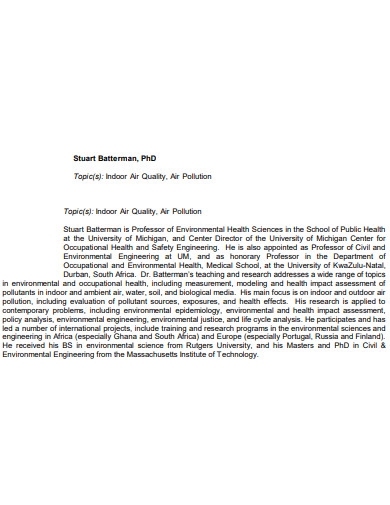
cohse.umich.edu
2. Short Work Bio Example
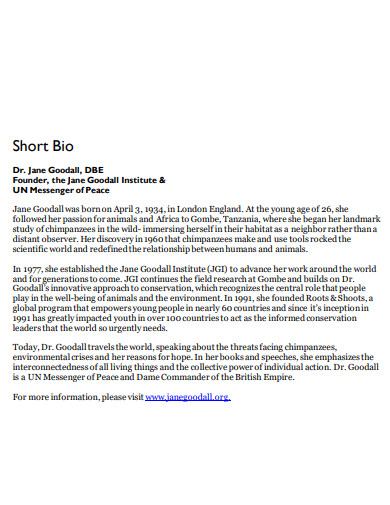
janegoodall.org
3. Sample Work Bio
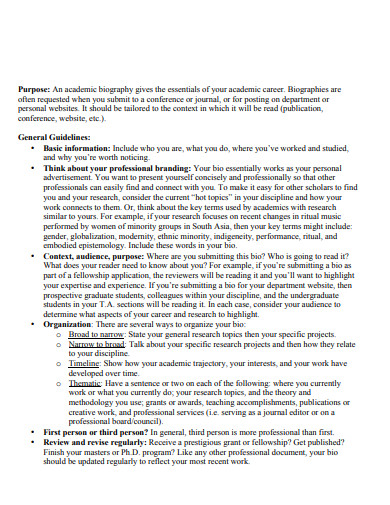
gwc.ucr.edu
4. Creative Work Bio Example
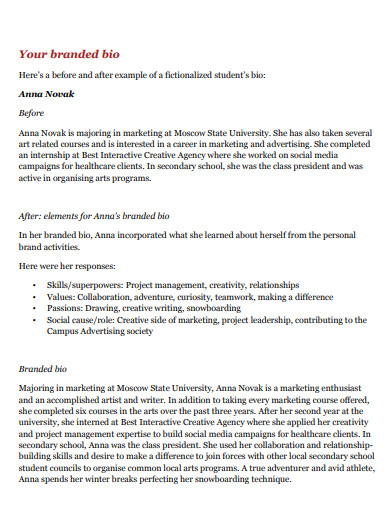
pwc.com
5. Student Work Bio Example
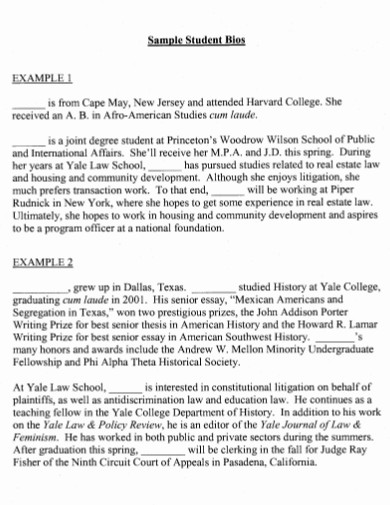
law.yale.edu
6. Accountant Bio Example
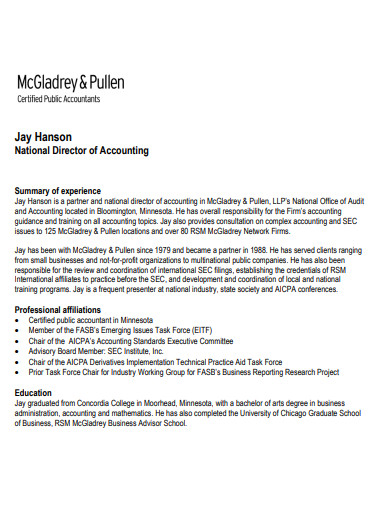
sec.gov
7. Biography Template
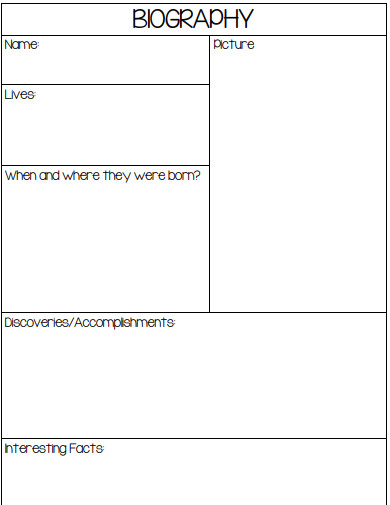
bpb-ap-se2.wpmucdn.com
8. Self Bio Example

simplystatedbusiness.com
What to include in a Bio for Work
A well-crafted work bio should provide a concise, engaging overview of your professional background, skills, and achievements. Here are key elements to include:
1. Full Name and Professional Title
- Start with your full name and current job title or professional designation.
- Example: “Jane Doe, Marketing Manager”
2. Professional Summary
- Offer a brief description of your current role and main responsibilities.
- Example: “Jane Doe is a results-driven Marketing Manager specializing in digital marketing strategies.”
3. Years of Experience
- Mention the number of years you have worked in your field.
- Example: “With over 10 years of experience in the marketing industry,”
4. Key Skills and Expertise
- Highlight your core skills and areas of expertise.
- Example: “Jane excels in social media marketing, content creation, and data analytics.”
5. Notable Achievements
- Include significant accomplishments or contributions in your career.
- Example: “She has successfully led campaigns that increased brand awareness and drove sales growth for Fortune 500 companies.”
6. Educational Background
- Provide details of your highest degree and any relevant certifications.
- Example: “Jane holds an MBA from Stanford University.”
7. Professional Affiliations
- Mention any relevant professional organizations or memberships.
- Example: “She is a member of the American Marketing Association.”
8. Personal Touch
- Add a small personal detail or interest to make your bio more relatable.
- Example: “In her spare time, Jane enjoys hiking and exploring new coffee shops.”
9. Contact Information
- If appropriate, include your professional contact details or a link to your LinkedIn profile.
- Example: “Connect with Jane on LinkedIn.”
10. Professional Photo (if applicable)
- Attach a professional headshot to make your bio visually appealing.
How to Write a Bio for Work
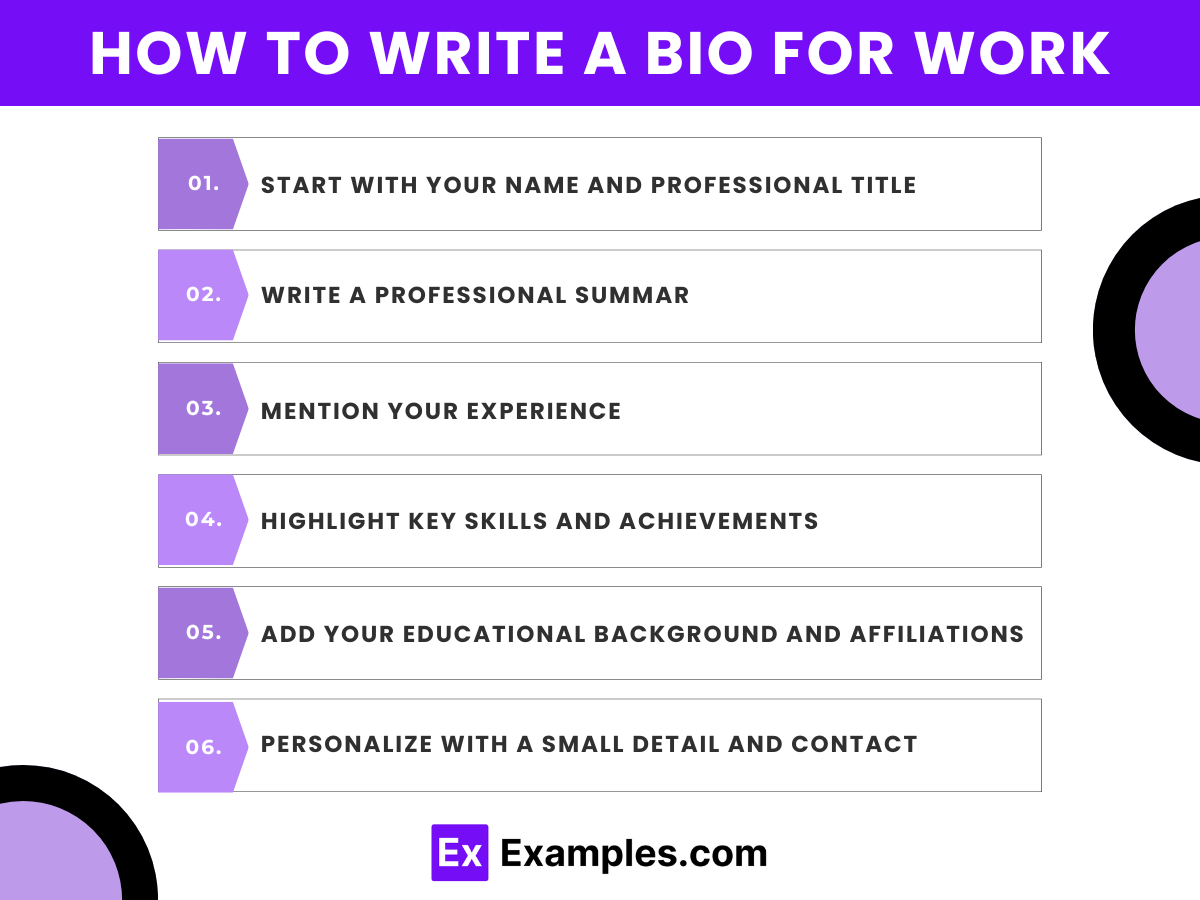
Writing a compelling bio for work involves highlighting your professional achievements, skills, and personal attributes in a concise and engaging manner. Follow these steps to create an effective bio:
1. Start with Your Name and Professional Title
- Introduce yourself with your full name and current job title.
- Example: “John Smith, Senior Software Developer”
2. Write a Professional Summary
- Provide a brief overview of your current role and main responsibilities.
- Example: “John Smith is a Senior Software Developer specializing in building scalable web applications.”
3. Mention Your Experience
- State the number of years you have worked in your field and any relevant positions.
- Example: “With over 8 years of experience in the tech industry,”
4. Highlight Key Skills and Achievements
- Focus on your core competencies, areas of expertise, and significant accomplishments.
- Example: “John excels in Java, Python, and JavaScript, and has developed innovative software solutions that have improved efficiency and reduced costs for his clients.”
5. Add Your Educational Background and Affiliations
- Provide details about your highest degree, any relevant certifications, and professional memberships.
- Example: “John holds a B.S. in Computer Science from MIT and is an active member of the Association for Computing Machinery (ACM).”
6. Personalize with a Small Detail and Contact Information
- Add a personal touch by including a hobby or interest, and if appropriate, provide professional contact details or a LinkedIn profile link.
- Example: “In his spare time, John enjoys coding side projects and hiking in the mountains. Connect with John on LinkedIn.”
How long should a professional bio be?
A professional bio should ideally be between 100-200 words, providing a concise overview of your career, skills, and accomplishments.
What should I include in my bio?
Include your name, job title, professional summary, years of experience, key skills, notable achievements, educational background, and any relevant professional affiliations.
Should I use first or third person?
Use the third person for a more professional tone. This makes the bio sound formal and appropriate for business contexts.
Can I include personal details in my bio?
Yes, including a small personal detail like a hobby or interest can make your bio more relatable and memorable.
How often should I update my bio?
Update your bio whenever you have significant changes in your professional life, such as a new job, promotion, or major accomplishment.
Where can I use my professional bio?
Use your bio on LinkedIn, company websites, professional networking sites, resumes, portfolios, and speaking engagement profiles.
How can I make my bio stand out?
Highlight unique achievements, use engaging language, and include specific examples of your work and impact in your field.
Should I tailor my bio for different audiences?
Yes, tailor your bio to fit the audience or purpose, emphasizing different skills or achievements depending on the context.
Is it important to include metrics or results?
Including metrics or specific results can add credibility to your bio, showcasing tangible impacts of your work and expertise.
Can I use humor in my bio?
A touch of appropriate humor can make your bio more engaging, but maintain a balance to ensure it remains professional.



